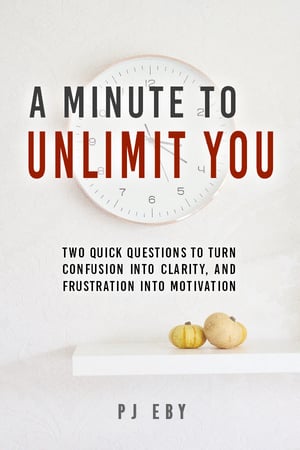It’s really strange, but ever since I started my blog, it seems like my life has been in some kind of fast-forward mode. Slowly at first, but then followed by four quantum leaps thereafter, as I’ve described here in The Multiple Self, Self, Version 2.0, Stretching Your Self, and The Opposite of Temptation. These articles mark what might be called the “inflection points” in my progress: sudden shifts from one plane of existence to another, with a corresponding increase in my ability to move towards my own goals, without being blocked by perfectionism, procrastination, self-doubt, self-handicapping, etc.
And yet, it now seems like it was all just preparation for the next few jumps, including the ones I took last week – and the ones I discovered I still need to make.
You see, I just got back from a long trip today. I spent the last five days in a seminar and a conference, to learn more about creating great workshops, and to line up some interesting guest speakers for the workshops and CDs I’ll be putting out next year. High-level discussions about joint ventures were also had, and there’s some possibility I’ll be doing a fitness-specific version of The Procrastination Cure for a fairly large “alternative” publisher. I even picked up some good tips on how to improve my vocal quality when giving seminars of my own.
And all of that is good and interesting in itself, but it was only the tip of the iceberg. Because the real “meat” that I got from both events was a long list of fears and guilts that I needed to cure myself of. As I sat through the seminar and talked to people at the conference, I found I had a ridiculous number of bad feelings about money, criticism, being in front of a group, and even a fear of allowing myself to like other people!
For example, I discovered that I use my earnest and “serious” disposition to avoid getting close to people that I don’t know very well, because of some childhood experiences of being tricked by people who pretended to like me in order to lure me into embarassing situations. Outside of a very small circle of close friends, I limit my emotional range to relatively “safe” expressions of laughter, enthusiasm, seriousness, and what I guess I’d call “caring professional” (for consulting, coaching, and day-job business situations) and “performance mode” (e.g. when giving a talk, doing magic, sales, training, and so on).
What do you care what other people think?
Luckily, in the last few months, I’ve learned to pay close attention to my feelings, so that I can eliminate the ones that block me from moving towards my dreams. So, as I listened to the speakers present what they were doing in their businesses similar to mine, I quickly noticed when I had conflicting feelings. For example, one speaker was talking about the use of a “squeeze page” (a page that requests an e-mail address before providing a person with information), and I noticed that I flinched at the idea.
I personally hate such pages, because I’d rather not give random people my email address. But that wasn’t why I flinched. After a moment’s thought, I realized that it was because I was afraid what other people (like you!) would think of me, if I marketed something using a squeeze page – regardless of whether or not you ever actually had to use it! And in fact, I realized that whether or not I ever choose to use a squeeze page at all, it didn’t make any sense to base my decision on a fear of what other people might think (as opposed to a rational pro/con analysis). As famous physicist Richard Feynman would say, “What do you care what other people think?”
Interestingly, all this came close on the heels of last week’s Planet Python flap, which saw lots of criticism coming my way for the contents of my blog. And from that, I found I had something like ten different feelings about criticism that needed taking care of, ranging from abject sorrow at rejection, to violent rage. Dealing with all that was one of my longest feeling-elimination sessions ever – and it still didn’t get the feeling that made me flinch at the conference.
So, these events highlight both the pluses and minuses of the feeling elimination technique. On the plus side, it works quickly and – so far as I can tell – permanently. On the minus side, it is sometimes extremely feeling-specific, and may require repeated applications to peel back several layers of feelings about things. For example, guilt or sorrow can mask fear, which in turn can mask anger. Different past experiences are often encoded with different intensities of feeling, in different places in the body, and the technique seems to strip off feelings in layers according to their type and intensity.
Sometimes a pervasive feeling applies to many situations, and it’s surprising how many things in your life were being affected by that one exact feeling. Other times, the feeling is linked only to a narrow range of things, and there are similar – but separately encoded – feelings for things that you would think would be covered by the “same” feeling. The more I push the limits of the technique, the more interesting the variations I discover!
Finding My Future
And by Saturday evening, I had a list of seven or so issues that I hadn’t had time to eradicate, because I couldn’t concentrate well enough in the seminar room to apply the technique. What little time I had outside of the seminar room and associated networking events was mostly spent online or on the telephone with current and future coaching clients. Sleep was something I only got about 5 hours of, most nights.
But I sacrificed it gladly, because this is the life for me.
When I started this blog two years ago, not long after I was laid off from Verio, I knew that Verio would be my last “corporate” job, ever. In fact, I had already decided that years before.
However, I didn’t really know what else I was going to do. I always assumed that I’d figure out creating some kind of web-based service business (this was before the term “Web 2.0” came into popular usage). Even though I had always wanted to do something “self-helpish”, I sort of assumed it would be something I’d get into after I had a successful business to pay the bills!
And that just goes to show you: never put something else ahead of your dreams. Because the thing you think you need to do “first” is precisely the thing that’s keeping you from seeing what you really want.
And I can look at my life now, in one of two ways. On the one hand, there is no life in the future, because it is always and only today. And on the other hand, I am living my life in the future, because the future that I want is already here today – even the parts that are still only in my mind. It may be some time before my part time projects become a full-time adventure, but when you are actively working on your dreams, it really is the journey that counts.
I’m Not the Only One Succeeding…
And that’s why I teach the Pathfinders several of the key skills I’ve mentioned in this article:
- Monitoring your feelings to discover and eliminate negative beliefs
- Creating goals that are motivating in the present, not just a stepping stone to some ill-defined future
- Bringing the future into the present, in order to experience life in every moment
The latter two, in particular, will be key topics during this weekend’s Instant Motivation workshop. And there are a few openings left, if you join the Seven Days to Live Your Dreams program now. I was in such a rush to prepare a sample copy of The Procrastination Cure before I left town last week (so I could show it around at the networking events), that I didn’t have time to update the registration pages. Which means that the old, low prices are still showing there!
So, you still have a little bit of time to get in at those prices. I’ve got a lot of “day job” work to catch up on in the next few days, so I won’t be able to update the registration pages just yet. So you can still fax in a registration with the old prices, and I’ll honor them, for now. By this Saturday I’ll be removing the “Basic” registration, and only providing “Intensive” and higher-level memberships, because you’ll need the extra coaching at “Intensive” level to catch up with the other Pathfinders, who are saying things like these in the members-only forums:
I have not experienced the grudging “have to cut the grass, have to vaccuum the house” feelings. I’ve seen that these jobs needed doing, I saw the time in the day when I could do them, and I just did them. (You wouldn’t believe the effort it took to make myself do them before!) …. I used to feel very virtuous when I did what I felt I was supposed to do or should do (ie, get up early, vaccuum the house, satisfy my writing group obligations). Now, when I do these things, I just do them. I kind of miss that virtuous feeling, but I kind of don’t. I now note an objective sense of satisfaction when I take care of these small tasks. And I find I have time to do more fun stuff when these jobs are out of the way. – “M”
I really took last week’s decision-making seminar to heart. Indecision really is suffering, and I’ve been suffering from keeping too many options open for months now…. After the seminar was over, [my partner] and I had a long talk about what we wanted to do. By the time we arrived at [our destination], we had decided several things: [list deleted to preserve privacy] …. We felt better almost immediately. – “J”
I have overcome most of my difficulties with the technique of zapping feelings and have been through a virtual thesaurus of them: anger, hate, bitterness, abandonment, jealousy, sorrow, grief, disappointment, fear, worthlessness, hopelessness, helplessness. – “B”
And these comments are after only the first three workshops. I can’t wait to see what they’ll be saying by Christmas!
Don’t Wait For The Future
And if you haven’t yet heard the first workshop recording, you can still get a free copy if you buy my book. I figure I might as well extend that offer a little longer too, because I’m not actually going to have The Procrastination Cure ready to sell or ship this month. So, you might as well take advantage of my schedule slip here to snag an MP3 copy of Banish Unwanted Feelings Forever. (If you own one of the 100 copies of my book that have already been sold, you can email secondchance “at” dirtsimple.org to request a download link for the workshop, until October 31.)
So don’t wait around. Sign up now. And if you haven’t bought You, Version 2.0 yet, take note that 2/3rds of the copies are already gone forever, and I will not be reprinting it. I do have plans to write new book(s) next year, but they will not be simple collections of my blog articles. (That doesn’t mean I won’t ever do other article reprint collections, but You, Version 2.0 will remain a unique and valuable collector’s item, especially since every copy is numbered and signed by me.)












You say you eliminated a lot of subtly overlapping unwanted emotions in reponse to criticism. Have you considered that this is actually the normal process of getting over something?
Normally when I feel bad about something a lot of emotions come into play, and it takes a while for me to feel better. You seem to describe a similar process consuming a certain amount of time as well.
Since you appear to have the idea that you can get rid of unwanted feelings rapidly and consciously, you have to invoke the concept of lots of subtly different feelings that morph into each other that you can then zap quickly and effectively. Meanwhile you’re taking a while to get over things too.
Er, no. It doesn’t work that way at all.
First off, the amount of time involved is quite different. The last time I had a stream of criticism coming at me (re: setuptools), it took days after the criticism *stopped* before I got over it. This time, I was done while it was still coming in, and my reactions to later input was reduced as I passed through the layers.
Second, the technique requires identifying the location of the feelings in one’s body, and most of the distinctions are not at all subtle, as one moves from feelings that are in the belly to ones that are in the chest, throat, or jaw. So as long as you pay attention to this instead of what you would *call* the feeling, then they are mostly very distinct. It’s comparatively infrequent that one finds the differences to be particularly subtle.
Third, the removal of feelings frequently produces persistent changes to behavior and beliefs, without the need for repeated application of the technique. For example, I stopped having qualms about the idea of using a “squeeze page” as soon as I removed the feeling associated with it. And since I removed my broad-based despair feeling a couple of months ago, a wide range of self-destructive behaviors went away immediately, and my ability to respond intelligently in stressful situations went way up.
Finally, eliminating my “have to” feeling cured me of virtually all procrastination. (It was after that, that I came up with the idea of creating “The Procrastination Cure”.)
Oh, and your saying “consuming a certain amount of time” implies something that isn’t really the case. It takes less than a minute to remove a feeling, once you notice that it *is* a feeling, and not “reality”. It’s very easy to think that what you’re currently feeling is “justified” by external reality, and thus not notice that it’s really just a feeling. Improving the speed of this recognition thus improves one’s speed of eliminating the overall set of patterns.
Oh, and one more difference: getting over feelings without this technique requires avoiding the situations that trigger the feelings. Getting over feelings *with* this technique is much easier when you are repeatedly exposing yourself to the triggering situation. It is in fact like TDD: I expose myself to the trigger by thinking about it, and examine my feelings. Then I perform the technique, and think about the trigger again. If there is still a reaction, I repeat the technique on the new reaction. When my new “code” passes the “test” (i.e., produces no reaction), then I am finished.
For example, at one point I traced back a feeling about criticism that brought back memories of schoolyard bullying and tears. When I was finished and thought about the same criticism again, I instead felt a pure rage. Removing that left something like annoyance, and removing that then produced indifference. That entire sequence took only minutes.
So, your suggestion is interesting, but significantly at odds with the facts in several ways. “Getting over something” is something that has to be repeated for each instance of the “something”. Elimination, on the other hand, is just that. Elimination. I “got over” the feeling of “have to” on a global basis: I no longer feel that way about *anything*. If I were just “getting over” it, I should have to do so for each individual thing I “have to” do, and that’s simply not the case.
The times that the process works in consciously-unexpeced ways simply highlight the differences between how we consciously categorize situations and feelings, versus how our conditioned reflexes categorize them. Frequently, the categories used to trigger feelings are either far more broad or far more narrow than we would consciously expect, because they’re mostly formed below the age of five, before we have continuous conscious awareness. Thus, changing one feeling may affect a very wide range of situations, or only a single narrow situation, and there isn’t any way to tell in advance which it will be.